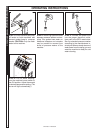
97-6133 • Rev. 5/07
13
PRESSURE WASHER
OPERATOR’S MANUAL
PREVENTATIVE MAINTENANCE
1. Use clean fuel - kerosene, No. 1 home heating
fuel or diesel. Clean or replace fuel filter every
100 hours of operation. Avoid water contaminated
fuel as it will seize up the fuel pump. De-soot coils
monthly. Use an additive if diesel is being used.
2. Check to see that the attached pressure washer
water pump is properly lubricated.
3. Follow winterizing instructions to prevent freeze
damage to pump and coils.
4. Always neutralize and flush detergent from system
after use.
5. If water is known to be high in mineral content, use
a water softener on your water system, or de-scale
as needed.
6. Do not allow acidic, caustic or abrasive fluids to
be pumped through system.
7. Always use high grade quality cleaning prod-
ucts.
8. Never run attached pressure washer pump dry for
extended periods of time.
9. If machine is operated with smoky or eye burning
exhaust, coils will soot up, not letting water reach
maximum operating temperature. (See section on
Maintenance and Service).
10. Never allow water to be sprayed on or near the
motor or burner assembly or any electrical com-
ponent.
11. Delime coils as per instructions.
It is advisable, periodically, to visually inspect the
burner. Check air inlet to make sure it is not clogged
or blocked. Wipe off any oil spills and keep equipment
clean and dry.
The areas around the machine should be kept clean
and free of combustible materials, gasoline and other
flammable vapors and liquids.
The flow of ventilating air to the burner must not be
blocked or obstructed in any manner.
MAINTENANCE AND SERVICE
Winterizing Procedure:
Damage due to freezing is not covered by warranty.
Adhere to the following cold weather procedures when-
ever the washer must be stored or operated outdoors
under freezing conditions.
During winter months, when temperatures drop be-
low 32°F, protecting your machine against freezing
is necessary. Store the machine in a heated room. If
this is not possible use compressed air on the short
hose end. By injecting compressed air, all water will
be blown out of the system. Run anti-freeze through
the system.
Rupture Disk:
For safety, each machine is equipped with a rupture
disk. In the event the pressure of the water should ex-
ceed 8000 PSI, the rupture disk will release pressure
and water on to the ground.
When the disk ruptures, it will need to be replaced.
NOTE: Turn burner switch off. Then open spray
gun to cool heating coil or rupture disk will burst
over time.
Adjustable Thermostat:
The adjustable thermostat can be set between 100°F
to 225°F (37.8° to 108°C). The temperature is depen-
dent on water flow and ambient water temperature.
Cleaning of Coils:
In alkaline water areas, lime deposits can accumulate
rapidly inside the coil pipes. This growth is increased
by the extreme heat build up in the coil. The best
prevention for liming conditions is to use high quality
cleaning detergents. In areas where alkaline water is
an extreme problem, periodic use of Deliming Pow-
der will remove lime and other deposits before coil
becomes plugged.
Deliming Coils With A Pressure Washer:
Periodic flushing of coils or optional float tank is rec-
ommended.
Step 1 Fill a 5 gallon bucket with 4 gallons of water,
then add 1 lb. of deliming powder. Mix thor-
oughly.
Step 2 Remove the high pressure nozzle from the
pressure wand and put the wand into the
bucket. Secure the trigger on the spray gun
in the open position.
Step 3 Attach a short section (3-5 ft.) of garden hose
to the attached pressure washer to siphon
solution from the elevated bucket. Start up
pressure washer, allowing solution to be
pumped through pressure washer and into
coils and back into the bucket. Solution should
be allowed to circulate 2-4 hours.
Step 4 After circulating solution flush entire system
with fresh water.
Removal of Soot In Heating Coil:
In the heating process fuel residue, in the form of soot
deposits, may develop between the heating coil pipes
and block air flow which affects burner combustion.
When soot has been detected on visual observation,
the soot on the coil must be cleaned off.


















